Energy Storage Science and Technology ›› 2024, Vol. 13 ›› Issue (6): 1824-1834.doi: 10.19799/j.cnki.2095-4239.2024.0085
• Energy Storage Materials and Devices • Previous Articles Next Articles
Jianhang YANG1( ), Wenting FENG2, Junwei HAN2, Xinru WEI2, Chenyu MA2, Changming MAO1(
), Wenting FENG2, Junwei HAN2, Xinru WEI2, Chenyu MA2, Changming MAO1( ), Linjie ZHI2,3, Debin KONG2,3(
), Linjie ZHI2,3, Debin KONG2,3( )
)
Received:2024-01-27
Revised:2024-03-06
Online:2024-06-28
Published:2024-06-26
Contact:
Changming MAO, Debin KONG
E-mail:yjh2221040438@163.com;mcm@quest.edu.cn;kongdb@upc.edu.cn
CLC Number:
Jianhang YANG, Wenting FENG, Junwei HAN, Xinru WEI, Chenyu MA, Changming MAO, Linjie ZHI, Debin KONG. Recent advances in rechargeable Li/Na-Cl2 batteries: From material construction to performance evaluation[J]. Energy Storage Science and Technology, 2024, 13(6): 1824-1834.
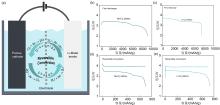
Fig. 1
(a) Schematic diagram of the reaction mechanism of rechargeable Li-Cl2 batteries; (b) Initial galvanostatic discharge curve of the Na-Cl2 battery; (c) Initial galvanostatic discharge curve of the Li-Cl2 battery; (d) Reversible galvanostatic charge-discharge curves of the Na-Cl2 battery; (e) Reversible galvanostatic charge-discharge curves of the Li-Cl2 battery"

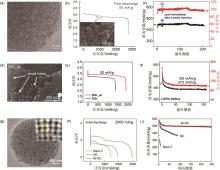
Fig. 2
(a) TEM image of the aCNS cathode[15]; (b) Initial discharge curve of the aCNS cathode[15]; (c) Cycling performance of the aCNS cathode[15]; (d) SEM image of and DGr_ac cathode[27]; (e) Initial discharge curves of the DGr and DGr_ac cathode[27]; (f) Cycling performance of the DGr_ac cathode[27]; (g) TEM and HAADF images of the Bi-NC cathode[29]; (h) Initial galvanostatic discharge curves of the Na-Cl2 battery with bare C, NC and Bi-NC[29]; (i) Cycling performance of the Na-Cl2 battery with bare C, NC and Bi-NC[29]"

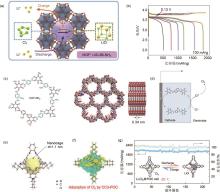
Fig. 3
(a) Reaction mechanism graph of the UiO-66-NH2 cathode[30]; (b) Charge/discharge curves for different cut-off capacity of UiO-66-NH2[30]; (c) Structure of COF-NH2[31]; (d) COF-NH2 assembled battery working diagram[31]; (e) Crystal structure of the CC3-POC[32]; (f) Chlorine adsorption by CC3-POC[32]; (g) Cycling performance graph of CC3-POC assembled battery at -20 ℃[32]"

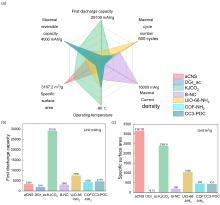
Fig. 4
(a) Performance comparison chart of different cathode materials in terms of first discharge capacity, maximal reversible capacity, maximal cycle number, specific surface area, maximal current density and operating temperature; (b) Comparison diagram of first discharge capacity of different cathode materials; (c) Comparison diagram of surface area of different cathode materials"

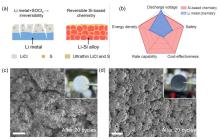
Fig. 6
(a) Schematic diagram of Li metal and Li-Si alloy surfaces after cycling[34]; (b) Comparison of Li metal and Li-Si alloy anodes in terms of discharge voltage, energy density, multiplier performance, cost and safety[34]; (c) SEM image of Li metal after 20 cycles[34]; (d) SEM image of Li-Si metal after 20 cycles[34]"

| 1 | SONG Y Z, LIU X, REN D S, et al. Simultaneously blocking chemical crosstalk and internal short circuit via gel-stretching derived nanoporous non-shrinkage separator for safe lithium-ion batteries[J]. Advanced Materials, 2022, 34(2): e2106335. |
| 2 | LIU W, ZONG K, GHANI U, et al. Ternary lithium nickel boride with 1D rapid-ion-diffusion channels as an anode for use in lithium-ion batteries[J]. Small, 2023: e2309918. |
| 3 | YOU H Z, ZHU J G, WANG X Y, et al. Nonlinear health evaluation for lithium-ion battery within full-lifespan[J]. Journal of Energy Chemistry, 2022, 72: 333-341. |
| 4 | PAREKH M H, PALANISAMY M, POL V G. Reserve lithium-ion batteries: Deciphering in situ lithiation of lithium-ion free vanadium pentoxide cathode with graphitic anode[J]. Carbon, 2023, 203: 561-570. |
| 5 | SONG K, AGYEMAN D A, PARK M, et al. High-energy-density metal-oxygen batteries: Lithium-oxygen batteries vs sodium-oxygen batteries[J]. Advanced Materials, 2017, 29(48): 1606572. |
| 6 | SONG Y Z, WANG X Q, CUI H, et al. Probing the particle size dependence of nonhomogeneous degradation in nickel-rich cathodes for high-energy lithium-ion batteries[J]. eTransportation, 2023, 16: 100223. |
| 7 | LI Z N, SAMI I, YANG J, et al. Lithiated metallic molybdenum disulfide nanosheets for high-performance lithium-sulfur batteries[J]. Nature Energy, 2023, 8: 84-93. |
| 8 | LI Z J, YANG J H, ZHOU Z F, et al. Growth confinement and ion transportation acceleration via an in situ formed Bi4Se3 layer for potassium ion battery anodes[J]. Applied Surface Science, 2023, 621: 156785. |
| 9 | QIN X L, ZHAO X, ZHANG G B, et al. Highly reversible intercalation of calcium ions in layered vanadium compounds enabled by acetonitrile-water hybrid electrolyte[J]. ACS Nano, 2023, 17(13): 12040-12051. |
| 10 | TAO R Q, FU H W, GAO C T, et al. Tailoring interface to boost the high-performance aqueous Al ion batteries[J]. Advanced Functional Materials, 2023, 33(48): 2303072. |
| 11 | WANG J W, CHEN Y L, ZHAO Y F, et al. CO2 capture membrane for long-cycle lithium-air battery[J]. Molecules, 2023, 28(5): 2024. |
| 12 | WANG M, SUN W H, ZHANG K, et al. Synergy between the coordination and trace ionization of co-solvents enables reversible magnesium electroplating/stripping behavior[J]. Energy & Environmental Science, 2024, 17(2): 630-641. |
| 13 | ZHOU W, ZENG G L, JIN H T, et al. Bio-template synthesis of V2O3@Carbonized Dictyophora composites for advanced aqueous zinc-ion batteries[J]. Molecules, 2023, 28(5): 2147. |
| 14 | 张鼎, 叶子贤, 刘镇铭, 等. 钠离子电池黑磷基负极材料研究进展[J]. 储能科学与技术, 2023, 12(8): 2482-2490. |
| ZHANG D, YE Z X, LIU Z M, et al. Research progress of black phosphorus-based anode materials for sodium-ion batteries[J]. Energy Storage Science and Technology, 2023, 12(8): 2482-2490. | |
| 15 | ZHU G Z, TIAN X, TAI H C, et al. Rechargeable Na/Cl2 and Li/Cl2 batteries[J]. Nature, 2021, 596: 525-530. |
| 16 | CHEN S Y, XU Z W, LI M F, et al. Tailoring fluorine-substituted cobalt phthalocyanine/activated carbon nanocomposites for stable and long-life Li/SOCl2 batteries[J]. Journal of Electroanalytical Chemistry, 2023, 935: 117345. |
| 17 | LI X, HUANG X Y, GAO R M, et al. Improved performance of Li/SOCl2 batteries using binuclear metal azaphthalocyanines as electrocatalysts[J]. Electrochimica Acta, 2016, 222: 203-211. |
| 18 | XIA M T, FENG Y H, WEI J M, et al. A rechargeable K/Br battery[J]. Advanced Functional Materials, 2022, 32(38): 2205879. |
| 19 | XU Q C, GENG S T, YUAN B, et al. A low-cost and recyclable Mg/SOCl2 primary battery via synergistic solvation and kinetics regulation[J]. Advanced Functional Materials, 2023, 33(5): 2210343. |
| 20 | ZHANG R L, WANG R Q, LUO K, et al. Multi-walled carbon nanotubes chemically modified by cobalt tetraaminophthalocyanines with excellent electrocatalytic activity to Li/SOCl2 battery[J]. Journal of the Electrochemical Society, 2014, 161(14): H941-H949. |
| 21 | SU X Q, SUN W J, LI J, et al. The use of porphyrins as electrocatalyst in lithium/thionyl chloride (Li/SOCl2) battery[J]. ECS Electrochemistry Letters, 2014, 3(6): A39-A40. |
| 22 | WEI J H, GAO X T, TAN S P, et al. Acetylene black loaded on graphene as a cathode material for boosting the discharging performance of Li/SOCl2 battery[J]. International Journal of Electrochemical Science, 2017, 12(2): 898-905. |
| 23 | LIANG P, ZHU G Z, HUANG C L, et al. Rechargeable Li/Cl2 battery down to -80 ℃[J]. Advanced Materials, 2024, 36(7): 2307192. |
| 24 | SHEN F, WANG S F, GAO Y. Making SOCl2 rechargeable[J]. Joule, 2021, 5(11): 2766-2767. |
| 25 | 黎红, 杨林億. 锂/亚硫酰氯电池的发展现状[J]. 船电技术, 2009, 29(8): 57-60. |
| LI H, YANG L Y. Development states of lithium/thionyl chloride battery[J]. Marine Electric & Electronic Engineering, 2009, 29(8): 57-60. | |
| 26 | ZHU G Z, LIANG P, HUANG C L, et al. Shedding light on rechargeable Na/Cl2 battery[J]. Proceedings of the National Academy of Sciences of the United States of America, 2023, 120(39): e2310903120. |
| 27 | ZHU G Z, LIANG P, HUANG C L, et al. High-capacity rechargeable Li/Cl2 batteries with graphite positive electrodes[J]. Journal of the American Chemical Society, 2022, 144(49): 22505-22513. |
| 28 | MA C Y, FENG W T, KONG D B, et al. Vertical-channel cathode host enables rapid deposition kinetics toward high-areal-capacity sodium-chlorine batteries[J]. Small, 2024: 2310978. |
| 29 | XIANG L X, XU Q C, ZHANG H, et al. Ultrahigh-rate Na/Cl2 batteries through improved electron and ion transport by heteroatom-doped bicontinuous-structured carbon[J]. Angewandte Chemie International Edition, 2023, 62(47): 2312001. |
| 30 | XU Y, JIAO L, MA J L, et al. Metal-organic frameworks for nanoconfinement of chlorine in rechargeable lithium-chlorine batteries[J]. Joule, 2023, 7(3): 515-528. |
| 31 | XU Y, WANG M M, SAJID M, et al. Organocatalytic lithium chloride oxidation by covalent organic frameworks for rechargeable lithium-chlorine batteries[J]. Angewandte Chemie (International Ed in English), 2024, 63(7): e202315931. |
| 32 | XU Y, ZHANG S X, WANG M M, et al. Enrichment of chlorine in porous organic nanocages for high-performance rechargeable lithium-chlorine batteries[J]. Journal of the American Chemical Society, 2023, 145(50): 27877-27885. |
| 33 | CHEN G D, LI W D, DU X F, et al. Transforming a primary Li-SOCl2 battery into a high-power rechargeable system via molecular catalysis[J]. Journal of the American Chemical Society, 2023, 145(40): 22158-22167. |
| 34 | YUAN B, WU L, GENG S T, et al. Unlocking reversible silicon redox for high-performing chlorine batteries[J]. Angewandte Chemie International Edition, 2023, 62(37): 2306789. |
| 35 | LI P, LI X L, GUO Y, et al. Development of an energy-dense and high-power Li-Cl2battery using reversible interhalogen bonds[J]. Chem, 2024, 10(1): 352-364. |
| [1] | Chencheng XU, Zhan WANG, Shuang LI, Jiangmin JIANG, Zhicheng JU. Research progress and engineering application prospects of prelithiation technology for lithium-ion batteries [J]. Energy Storage Science and Technology, 2025, 14(3): 930-946. |
| [2] | Tong LIU, Guiting YANG, Hui BI, Yueni MEI, Shuo LIU, Yongji GONG, Wenlei LUO. Recent progress in high-energy and high-power lithium-ion batteries [J]. Energy Storage Science and Technology, 2025, 14(1): 54-76. |
| [3] | Wenhao GONG, Meng LI, Tao ZHANG, Ruotao ZHANG, Yanxia LIU. Development and fabrication of high-energy and long-endurance Li-ion batteries for UAVs [J]. Energy Storage Science and Technology, 2024, 13(8): 2550-2558. |
| [4] | Miao LI, Yongli YU, Jianyang WU, Min LEI, Henghui ZHOU. Design of high-energy-density LiFePO4 cathode materials [J]. Energy Storage Science and Technology, 2023, 12(7): 2045-2058. |
| [5] | Ce ZHANG, Siwu LI, Jia XIE. Research progress on the prelithiation technology of alloy-type anodes [J]. Energy Storage Science and Technology, 2022, 11(5): 1383-1400. |
| [6] | Wenting JIN, Mansheng LIAO, Ji HUANG, Zidong WEI. The technological trend of high energy density Li-ion batteries for vehicles [J]. Energy Storage Science and Technology, 2022, 11(1): 350-358. |
| [7] | Mengdie YAN, Hui LI, Min LING, Huilin PAN, Qiang ZHANG. Brief review of progress in lithium-sulfur batteries based on dissolution-deposition reactions [J]. Energy Storage Science and Technology, 2020, 9(6): 1606-1613. |
| [8] |
ZOU Jian, WANG Bojun, YANG Jiachao, NIU Xiaobin, WANG Liping.
Electrochemical performance of β-Li0.3V2O5 as a lithium-ion battery cathode material
[J]. Energy Storage Science and Technology, 2020, 9(2): 353-360.
|
| [9] | ZHANG Yonglong, XIA Huiling, LIN Jiu, CHEN Shaojie, XU Xiaoxiong. Brief analysis the safety of solid-state lithium ion batteries [J]. Energy Storage Science and Technology, 2018, 7(6): 994-1002. |
| [10] | CAO Yong, YAN Changqing, WANG Yifei, LI Daocong, LIN Shaoyong, LIANG Dayu, DAI Beibei, HU Panpan, BIAN Lin, YANG Xulai, XU Xingwu. The technical route exploration of lithium ion battery with high safety and high energy density [J]. Energy Storage Science and Technology, 2018, 7(3): 384-393. |
| [11] | YANG Xulai, CHEN Houmei, GAO Er’ping. Project “development and application of lithium ion batteries with high specific energy density”#br# [J]. Energy Storage Science and Technology, 2017, 6(5): 1145-1147. |
| [12] | XIA Dingguo. Project “ Key technology and basic science problem reach for high energy density lithium batteries” [J]. Energy Storage Science and Technology, 2017, 6(1): 165-168. |
| [13] | LI Hong. Project “High energy density lithium batteries for long range EV” [J]. Energy Storage Science and Technology, 2016, 5(6): 915-918. |
| [14] | XIA Yonggao, LIU Zhaoping. Research progress on the Li-excess Mn-based cathode materials with high capacity for lithium-ion battery [J]. Energy Storage Science and Technology, 2016, 5(3): 384-387. |
| [15] | ZHANG Sanpei,WEN Zhaoyin. Review on sodium-air batteries [J]. Energy Storage Science and Technology, 2016, 5(3): 249-257. |
| Viewed | ||||||
|
Full text |
|
|||||
|
Abstract |
|
|||||
